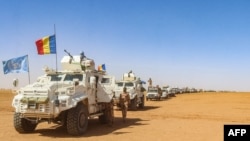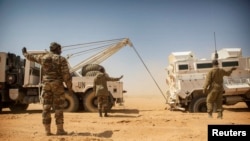The Permanent Strategic Framework, CSP — a Tuareg-dominated alliance of armed groups that recently relaunched a rebellion against the state — said in a statement Tuesday that it was "now taking control of the areas abandoned by MINUSMA in Kidal."
A convoy of peacekeepers made up of more than a hundred vehicles had earlier left the camp in a column of more than a hundred vehicles, heading for Gao, another key town in the north about 330 kilometers away, MINUSMA officials said.
It was the third and last camp to be evacuated by the mission in the Kidal region of Mali's volatile north, which has been wracked by jihadist and separatist violence.
Tuareg stronghold
MINUSMA's withdrawal has exacerbated tensions between the military and the rebel groups.
The mission had initially ensured that its camps were handed over to the Malian military, according to the rules of peacekeeping operations, but it is now leaving without doing so.
Mali's army said on social media that "once again and with much regret," MINUSMA was leaving without handing over the camp to the authorities.
By speeding up its withdrawal, the UN peacekeeping force is upsetting the plans of the Malian army, which does not want to let the separatists fill the vacuum.
Even before the camp takeover, tensions had been expected to rise further in the Kidal region when the UN departed.
Questions will now be raised about whether the Malian army will try to regain control of the region — the stronghold of the Tuareg rebellion and a major sovereignty issue for Mali's junta-led government.
The Kidal region has long been the centre of insubordination and a launching point for independence rebellions, which have shaken Mali since independence.
The army suffered humiliating defeats between 2012 and 2014 in the region.
The separatist groups, which had agreed to a ceasefire and a peace deal with authorities in 2014 and 2015, have recently resumed hostilities in the lead-up to MINUSMA withdrawal.
They do not want the peacekeepers to hand over their camps to the Malian army.
Mali's ruling junta, which seized power in 2020, in June ordered the peacekeepers out, proclaiming the "failure" of the UN mission.
While the final departure from Kidal was initially planned for the second half of November, a deterioration in security has pushed MINUSMA to accelerate its withdrawal from all bases, which has irritated the junta.
The army on October 2 dispatched a large convoy towards Kidal in anticipation of the UN's departure. The column is believed to still be in Anefis, approximately 110 kilometres south of the town of Kidal.
It also sent reinforcements to Tessalit, about 200 kilometers away.
Kidal is the eighth camp that MINUSMA has left since August in northern and central Mali. Four remain.
Obstructions
MINUSMA — the United Nations Multidimensional Integrated Stabilization Mission in Mali — said in a press release that departure conditions had been "extremely difficult and challenging."
It cited the "deteriorating security situation and the multiple threats to peacekeepers," as well as the difficulty of conducting air operations to extract personnel.
This has forced the mission to undertake long and dangerous journeys by road.
Spokesman for the UN Secretary General, Stephane Dujarric, told reporters in New York that the convoy from Kidal had hit two improvised explosive devices ,IEDs, along the way but no one had been injured.
The convoys departing from Tessalit and Aguelhok with around 500 Chadian peacekeepers hit four IEDs, causing four minor injuries, he said.
The mission comprises around 15,000 soldiers and police officers. About 180 of its members have been killed in hostile acts.
In addition to the rebellion in northern Mali, the al-Qaida-linked Support Group for Islam and Muslims, GSIM, has also stepped up attacks against the military.
That means that MINUSMA's pull-out is all the more perilous, taking place against the background of this renewal of hostilities — and on what are perceived to be restrictions imposed by the authorities on its ability to maneuver.
A confidential note to the U.N. Security Council from its Department of Peace Operations, seen by AFP, set out the obstacles faced by MINUSMA.
They included the withholding of flight or travel permits, an embargo on imports it needed and the impossibility of carrying out security patrols around its own camps.
The U.N. peacekeeping force says it has had to destroy or decommission equipment such as vehicles, ammunition and generators that it was unable to take away, in accordance with UN rules.












Forum